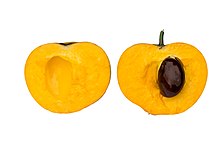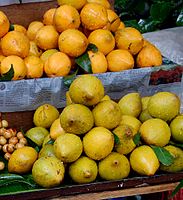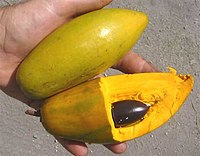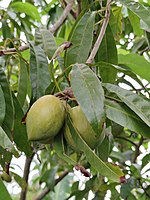| Canistel | |
|---|---|

| |
| Pouteria campechiana | |

| |
| Pouteria campechiana cross section | |
| Conservation status | |
 Least Concern (IUCN 3.1) | |
| Scientific classification | |
| Kingdom: | Plantae |
| Clade: | Tracheophytes |
| Clade: | Angiosperms |
| Clade: | Eudicots |
| Clade: | Asterids |
| Order: | Ericales |
| Family: | Sapotaceae |
| Genus: | Pouteria |
| Species: | P. campechiana |
| Binomial name | |
| Pouteria campechiana (Kunth) Baehni | |
| Synonyms | |
|
Lucuma campechiana Knuth | |

| Nutritional value per 100 g | |||||||||||||||||||||||||||||||
|---|---|---|---|---|---|---|---|---|---|---|---|---|---|---|---|---|---|---|---|---|---|---|---|---|---|---|---|---|---|---|---|
| Energy | 138.8 kcal (581 kJ) | ||||||||||||||||||||||||||||||
| Carbohydrates | 36.69 g | ||||||||||||||||||||||||||||||
| Dietary fiber | .10 g | ||||||||||||||||||||||||||||||
| Fat | .13 g | ||||||||||||||||||||||||||||||
| Protein | 1.68 g | ||||||||||||||||||||||||||||||
| |||||||||||||||||||||||||||||||
Source: Laboratorio FIM de Nutricion in Havana | |||||||||||||||||||||||||||||||
Pouteria campechiana (commonly known as the cupcake fruit, eggfruit, zapote amarillo or canistel) is an evergreen tree native to, and cultivated in, southern Mexico, Belize, Guatemala, and El Salvador. It is cultivated in other countries, such as India, Costa Rica, Brazil, the United States, the Dominican Republic, Australia, Cambodia, Vietnam, Indonesia, Sri Lanka, Nigeria, and the Philippines. The edible part of the tree is its fruit, which is colloquially known as an egg fruit.
The canistel grows up to 10 m (33 ft) high, and produces orange-yellow fruit, also called yellow sapote, up to 7 cm (2.8 in) long, which are edible raw. Canistel flesh is sweet, with a texture often compared to that of a hard-boiled egg yolk, hence its colloquial name "eggfruit". It is closely related to the lucuma, mamey sapote, and abiu.
Fruit description
The shape and size of the fruit is highly variable, depending on the cultivar. The better selections consistently produce large, ovate fruit with glossy skin weighing upwards of 400 g (14 oz). The flesh is somewhat pasty, although the best varieties have a creamy, mousse-like texture. The flavor is rich and is reminiscent of an egg custard. The fruit may contain one to six large, brown seeds.
The canistel displays climacteric fruit ripening. A fully mature fruit shows an intense yellow skin color. Eventually, it softens and drops from the tree. Insects and birds avoid the fruit flesh, perhaps due to its astringent properties, that are much reduced in senescent fruits, but still perceptible to the human palate. Apparently mature fruits severed from the tree while still hard often fail to develop the desired climacteric changes in terms of reduced astringency and a texture reminiscent of egg yolk.
Uses
Like the related lucuma, the canistel can be eaten fresh, and has the texture of a hard-boiled egg yolk. The ripe fruit can be made into jam, marmalade, pancakes, and flour. The ripe flesh is blended with milk and other ingredients to make a shake, and pureed, it is sometimes added to custards or used in making ice cream. It is also used in a milkshake known as "eggfruit nog".
The wood of the tree is occasionally used in construction where it is available, especially as planks or rafters. In its native range, it has been a source of latex used to adulterate chicle.
Etymology
Its specific name is derived from the Mexican town of Campeche, where it is native.
In the numerous countries where it is cultivated or sold, it is known by many vernacular names; canistel is common, as are variations on egg fruit and names referring to its yellow color. In the Philippines, it is called chesa, tiessa, or atiesa. In Sri Lanka, this fruit is known as lavul, laulu, lavulu, or lawalu. In Thailand, it is known by different traditional popular names such as lamut Khamen (ละมุดเขมร="Khmer sapodilla") or tho Khamen (ท้อเขมร="Khmer peach"), folk imagination attributing a hypothetical Cambodian origin to this fruit (the name of the fruit is see da in Cambodia). Currently, those names are discouraged by linguistic authorities and names making no reference to Cambodia, such as tiesa (ทิสซา), are officially favored.
The fruit is also given names after its unique yellow colour similar to an egg yolk: it is known as the buah kuning telur ("yolk fruit") in Malay, cây trứng gà ("chicken egg plant") in Vietnamese, mon khai (ม่อนไข่, khai meaning "egg") in Thai and danhuang guo (蛋黃果 "egg yolk fruit")in Taiwan.
It is called sawo mentega ("butter sapodilla", for its color and texture) throughout Southeast Asia. It is also known as alkesah in Indonesia.
Though relatively rare in East Africa, they can be found, and in the Swahili language, the fruit is confusingly named zaituni, which is the same word used to refer to olives.
The Taiwanese also call this fruit xiantao (仙桃), "peach of the immortals".
Plant gallery
References
- Botanic Gardens Conservation International (BGCI); IUCN SSC Global Tree Specialist Group (2019). "Pouteria campechiana". IUCN Red List of Threatened Species. 2019: e.T146704277A146779773. doi:10.2305/IUCN.UK.2019-2.RLTS.T146704277A146779773.en. Retrieved 24 December 2022.
- "Pouteria campechiana (Kunth) Baehni". Plants of the World Online. The Trustees of the Royal Botanic Gardens, Kew. n.d. Retrieved June 29, 2022.
- "Pouteria campechiana (Kunth) Baehni". Catalogue of Life. Species 2000. n.d. Retrieved June 29, 2022.
- "Pouteria campechiana". Integrated Taxonomic Information System. Retrieved 2014-02-26.
- ^ Julia F. Morton (1987). "Canistel". Fruits of Warm Climates. pp. 402–405. Retrieved 2010-09-24.
- "Pouteria campechiana". Germplasm Resources Information Network. Agricultural Research Service, United States Department of Agriculture. Retrieved 2009-01-29.
- ^ T. K. Lim (2013). Edible Medicinal And Non-Medicinal Plants: Volume 6, Fruits. Springer Science & Business Media. pp. 133–134. ISBN 9789400756281.
- Charles Boning (2006). Florida's Best Fruiting Plants: Native and Exotic Trees, Shrubs, and Vines. Sarasota, Florida: Pineapple Press, Inc. p. 53.
- ^ D.K.N.G. Pushpakumara (2007). "Lavulu". Underutilized fruit trees in Sri Lanka (PDF). World Agroforestry Centre, South Asia Office, New Delhi, India.
- Tong Kwee Lim (15 February 2013). Edible Medicinal And Non-Medicinal Plants: Volume 6, Fruits. Springer. p. 134. ISBN 978-94-007-5628-1.
- "มีเมล็ดละมุดเขมรหรือเซียนท้อจำหน่าย". Archived from the original on 2016-05-31. Retrieved 2012-08-17.
- ^ "7 Health Benefits of Canistel". Archived from the original on 2014-03-27. Retrieved 2020-05-10.
- ^ Fadzilah Awang-Kanak; Mohd Fadzelly Abu Bakar (2018). "Canistel - Pouteria campechiana". In Rodrigues, Sueli; de Oliveira Silva, Ebenezer; de Brito, Edy Sousa (eds.). Exotic Fruits Reference Guide. Academic Press. pp. 107–111. ISBN 978-0-12-803138-4.
External links
 Media related to Pouteria campechiana at Wikimedia Commons
Media related to Pouteria campechiana at Wikimedia Commons Data related to Pouteria campechiana at Wikispecies
Data related to Pouteria campechiana at Wikispecies
| Taxon identifiers | |
|---|---|
| Pouteria campechiana |
|
| Lucuma campechiana | |
- IUCN Red List least concern species
- Pouteria
- Crops originating from Mexico
- Crops originating from South America
- Trees of Northern America
- Trees of Belize
- Trees of Costa Rica
- Trees of Guatemala
- Trees of Nicaragua
- Trees of Panama
- Trees of the Yucatán Peninsula
- Trees of El Salvador
- Trees of Honduras
- Taxa named by Charles Baehni
- Taxa named by Carl Sigismund Kunth



